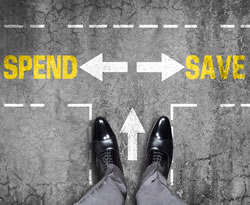Lauren Rouse* answers the age on question ‘How much of your income should you be saving?’
 Payday is a great day. But after the money comes in, it’s easy to be tempted into spending big on that item on your wishlist or to buy that more expensive gift.
Payday is a great day. But after the money comes in, it’s easy to be tempted into spending big on that item on your wishlist or to buy that more expensive gift.
Learning how to save more money is a matter of changing habits.
So how much should you be allocating to saving vs spending out of each paycheck?
How to save money with the 50-30-20 split
There have been countless finance methods for divvying up your income, but the folks at Money.com reckon this is an easy rule.
Split up your paycheck with a 50-30-20 breakdown.
50 per cent towards living expenses, 30 per cent towards everyday spending and 20 per cent into savings.
It’s recommended this split occurs after taking into account things like superannuation and tax.
For example, from your full paycheck, it’s a good idea to match the amount of super your employer is contributing as a voluntary contribution.
Then divide up the income from there.
Tax is usually deducted automatically in Australia.
But if it’s not, like when being paid as a freelancer or declaring another type of income, it’s worth allowing some room for the tax you’ll need to pay back.
What should you do with that 20 per cent?
So you’ve successfully allocated 20 per cent for savings, but what should you do with it?
Adam Goetz, president of the MassMutual Advisors Association, told Money.com that building an emergency fund is a great place to start.
Goetz recommends that people have 6 months worth of expenses saved up in a separate account, in case something unexpected happens.
Pandemic anyone?
Financial planner, Tania Brown, also recommends then splitting your savings even further.
She suggests having one account for crisis cover and another for short-term non-essential expenses, like a holiday or new furniture.
The idea is that by having separate savings accounts for expenses, you won’t be as tempted to dip into your emergency savings.
For those who really want to get into saving, it can be worth setting up as many savings accounts as there are needs.
“As many ways as you can have specific uses for accounts will give you peace of mind,” Goetz said.
Above all, the idea is to get into the habit of saving.
Aiming for 20 per cent is a good benchmark, but even the smallest contribution to a savings account is a good start.
If you’re brand new to savings routines and would like to start small, finance Instagram account She’s On The Money has some really simple and easy to follow templates to help guide you towards small savings goals like $5k and $10k over a 12 month period.
Give them a go, too.
Can’t hurt!
*Lauren Rouse is a writer at Lifehacker Australia.
This article first appeared at lifehacker.com.au.











